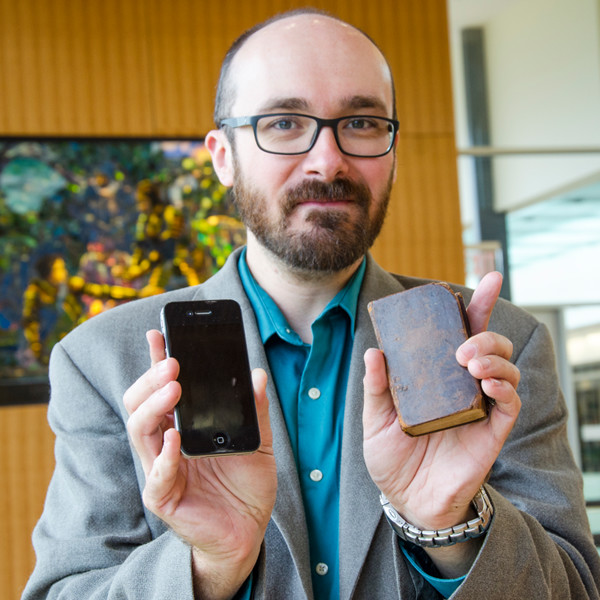With feet anchored in the past and head steered toward the future, Chris Phillips leads students on voyages of literary discovery.
In his Literature of the Sea course (#lafsealit), which dives into works by Melville, Thoreau, and other 19th century writers, Phillips (@MobyProf) innovates the classroom experience by using 21st century Twitter “as a kind of super-charged note-taking platform.” Volunteer students live-tweet the class discussions.
“On Twitter, you can have a set of notes readily available to anyone in the class, as well as anyone who’d like to listen in,” says Phillips, associate professor of English. Twitter followers have included Daniel Herman ’02, San Francisco-based educator/author of Zen and The White Whale, and Jeremy Pochman ’01, Nantucket, Mass., a champion sailor and co-founder of 11th Hour Racing, a nonprofit dedicated to bettering sailing and the environment.
“The students loved having other people paying attention to the work our class was doing. It’s given my classes a new way to keep track of where we are and given students with the inclination to learn with social media a way to give to the class.”

Phillips’ expertise in literary history and digital scholarship also mesh in the project to convert the 19th Century handwritten ledgers of the Easton Library Company into an electronic database which is set to go live at year’s end. Not only is Phillips’ project on the cutting edge—among only a handful of others in progress around the country–it is more rare in the fact that the Easton records begin in 1811. The largest book category was fiction, accounting for 40 percent, followed by periodicals, history, travels, belles-lettres (artistic and imaginative literature), biography, and science/medicine.
EXCEL Scholars Gavin Jones ’14, Eric Bockol ’16, Vanessa Milan ’16, Cat Miller ’16, Gigi O’Hanlon ’16, Sean Cavanagh ’18, and Alena Principato ’16, and Eric Luhrs, Skillman Library head of digital scholarship services, work with Phillips on the project.
Read about the Easton Library Company project
What’s next for this intrepid literary explorer?

English professor Chris Phillips spans centuries and media–from an original 18th Century Isaac Watts’ hymnal to an iPhone.
Phillips has secured two prestigious post-doctoral fellowships to enable the research and writing of The Hymnal Before the Notes: A History of Reading and Practice. The National Endowment for the Humanities will underwrite research at the Library Company of Philadelphia and a Frederick Burkhardt Fellowship from the American Council of Learned Societies will support work at vast collection of the American Antiquarian Society in Worcester, Mass. The Hymnal Before the Notes will focus on the ways in which people used and lived with hymnbooks before they had interlined music printed with the words, roughly before 1860.
Phillips is intrigued by “lived religion . . . the theology people live with.” As a doctoral candidate teaching assistant at Stanford, Phillips first saw a Baptist hymnbook edited by Joshua Smith and Samuel Sleeper from the late 1700s.
“It was a small, almost pocket-size book with a lot of wear to it, and I was especially struck by its subtitle: ‘for the use of religious assemblies and private Christians.’ I’d been looking for a hymn text to show my students something entire congregations would have sung, but when I found this source for the text, I started wondering how a book like this might be used outside of a church service.”
A primary utility of the hymns was a mnemonic device to excite children about learning. The books influenced recitation culture and the development of school reading books by McGuffey and Webster.
The hymnbooks also were tools for defining and announcing the identity of a “breakout denomination” such as the Philadelphia African Methodist Episcopal Church founded in the late 18th Century by the Reverend Richard Allen.
The hymnbooks also introduced ordinary people to poetry, says Phillips. “[Literary] poetry was learned and flowery but a lower level of understanding was required for the hymns.”
“I’ve taught a course on 19th-century American poetry, and one of the things I emphasize in that course is that we have to improve our understanding of how people of that time did their reading if we are to understand why the poetry is written in the way that it is with regular meters and moral messages.”
“Frequently in my classes I invite students to ask, ‘How am I reading this text? What is it asking of me? How am I responding?’ Literature calls for a response, but that call can be easy to ignore if you’re not listening for it. With hymns, it’s different—responding to the call is an expectation of the form. Working with hymns has helped me examine my own reading practices and made the act of reading much stranger and more an object of study in my classes than it was before.”
Chris Phillips is the author of Epic in American Culture, Settlement to Reconstruction (Johns Hopkins University Press, 2012) and the recipient of Thomas Roy and Lura Forrest Jones Faculty Lecture Awards in recognition of excellence in teaching and scholarship. He chaired the 10-member faculty steering committee for a four-year $700,000 grant from the Andrew W. Mellon Foundation to advance the increasing participation of faculty and students in the digital humanities.

